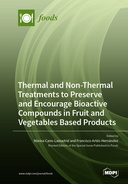Explore

Thermal and Non-Thermal Treatments to Preserve and Encourage Bioactive Compounds in Fruit and Vegetables Based Products
0 Ungluers have
Faved this Work
Login to Fave
Fruit- and vegetable-based products (F&Vs) have been conventionally processed using thermal techniques such as pasteurization, scalding, and/and drying, ensuring microbial safety and/or enzyme deactivation. Although thermal treatments are the most cost-effective tools, they could also reduce bioactive compounds, nutrients, and even sensory attributes. Nowadays, non-thermal food-processing technologies such as UV light and high-pressure processing have been proposed to develop food products with extended shelf life and preserved/encouraged bioactive compounds, while preserving the sensory properties. This reprint addresses the existing knowledge gaps of novel thermal and non-thermal techniques in the production of F&Vs and their derivatives. This reprint focuses on the effect of thermal and non-thermal treatments (light stresses, high hydrostatic pressure, pulse electric fields, oscillating magnetic fields, cold plasma, ultrasound, drying, etc.) on shelf-life, key bioactive compound changes (antioxidants, nutraceuticals, flavonoids, and non-flavonoids), enzymatic antioxidant systems, and non-enzymatic antioxidant systems of fruit- and vegetable-based products. Apart from an editorial written by the guest editors, the Special Issue consists of 13 papers that cover a range of subjects: thermal and non-thermal treatments on whole fruits (n = 4); thermal and non-thermal treatments on fruit and vegetable byproducts (n = 3); and, thermal and non-thermal treatments on fruit-based beverages and purées (n = 6).
This book is included in DOAB.
Why read this book? Have your say.
You must be logged in to comment.
